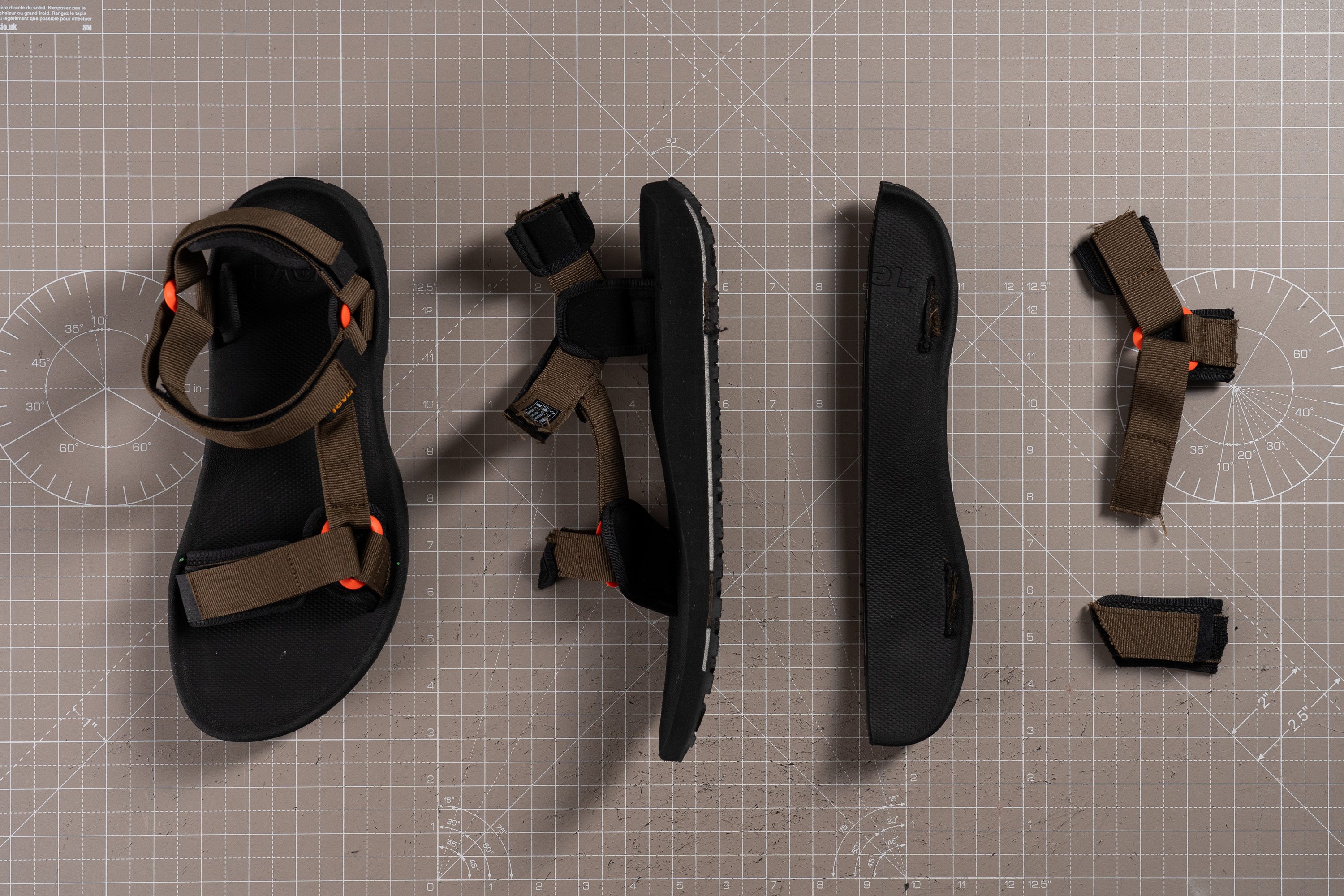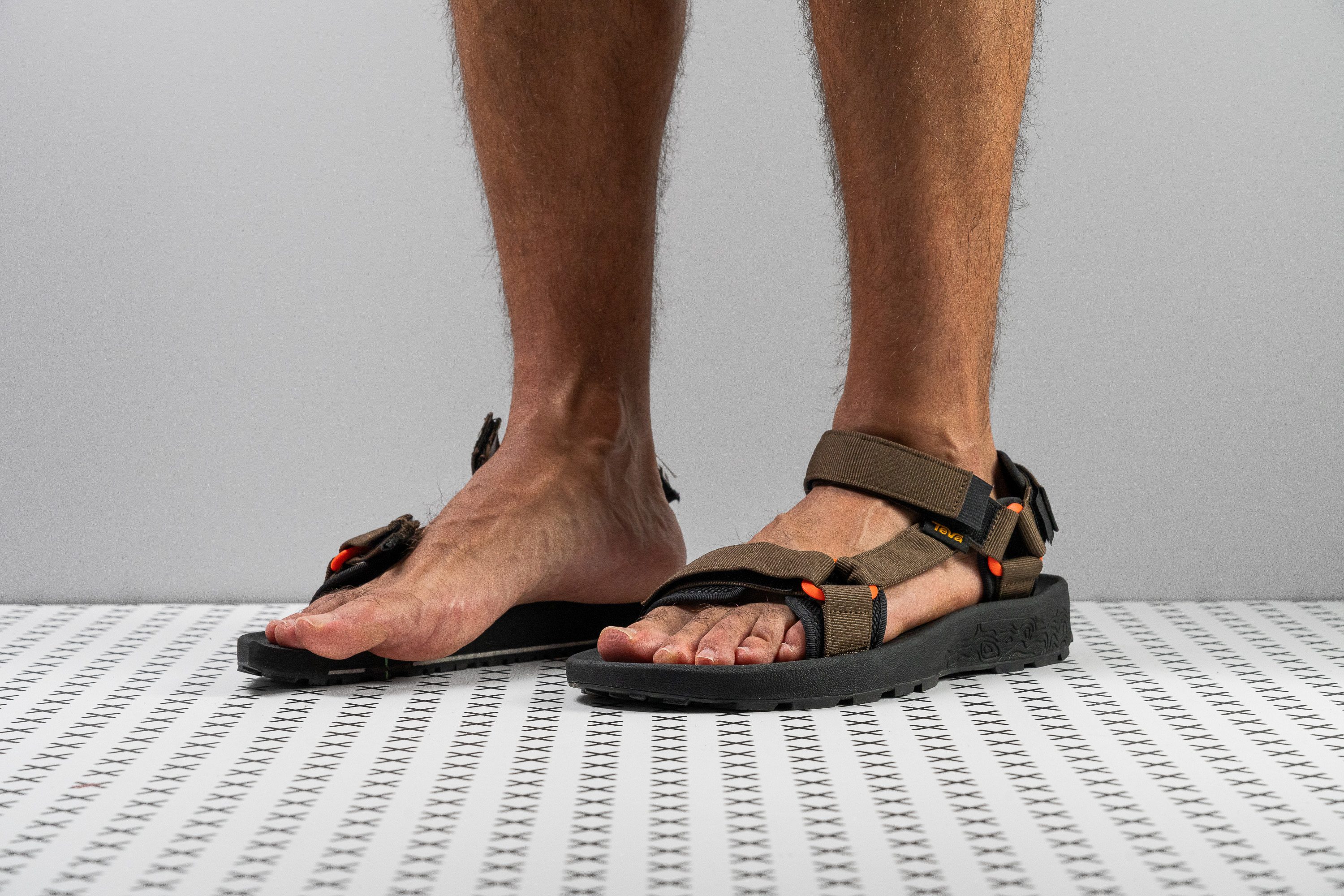Nuestra conclusión
Pros
- Versátiles: actividades acuáticas, senderismo ligero, uso diario
- Buena relación calidad-precio
- Amortiguación más blanda y cómoda
- Plataforma ancha y estable
- Agarre mejorado en superficies mojadas
- Estructura muy flexible
- Las correas acolchadas hacen que no te salgan ampollas
- Un alto % de componentes reciclados
Contras
- El barro se atasca entre los tacos
- Ponérselas es difícil (las almohadillas se doblan)
Veredicto de los usuarios
Comparativa
Las sandalias de senderismo más parecidas
+ + Añadir unas zapatillas | |||||
|---|---|---|---|---|---|
| Puntuación global | 83 Buenas | 91 Excelentes | 81 Buenas | 89 Excelentes | |
| Precio | 90 € | 115 € | 120 € | 125 € | |
| Terreno de trail | Sencillo | Sencillo | SencilloModerado | SencilloModerado | |
| Absorción de impactos | Alta | Baja | Alta | Moderada | |
| Retorno de energía | Alto | - | AltoModerado | Alto | |
| Peso laboratorio Peso marca | 10.8 oz / 305g | 11.1 oz / 315g 12.3 oz / 350g | 11.6 oz / 329g 12.9 oz / 365g | 14.6 oz / 414g 15.2 oz / 431g | |
| Lightweight | ✓ | ✗ | ✗ | ✗ | |
| Use | Senderismo ligeroSenderismo acuático | Senderismo ligeroSenderismo acuático | Senderismo de un díaSenderismo ligeroMultideporteSenderismo acuático | Senderismo ligeroSenderismo acuático | |
| Construction | Tiras | Tiras | Punta cerrada | Punta cerrada | |
| Drop laboratorio | 11.7 mm | 7.6 mm | 3.2 mm | 9.3 mm | |
| Talla | Tallan bien | Tallan bien | Tallan bien | Tallan bien | |
| Rigidez de la mediasuela | Blanda | Equilibrada | Firme | Equilibrada | |
| Flexibilidad | Flexible | Flexible | Moderada | Rígida | |
| Dureza de la suela | Estándar | Muy dura | Estándar | Estándar | |
| Durabilidad de la suela exterior | Decente | Buena | Buena | Buena | |
| Grosor de la suela | Estándar | Estándar | Estándar | Estándar | |
| Profundidad del dibujo de la suela | 2.6 mm | 2.2 mm | 3.0 mm | 3.1 mm | |
| Altura de la suela en la zona del talón laboratorio | 29.2 mm | 20.5 mm | 26.2 mm | 27.0 mm | |
| Antepié | 17.5 mm | 12.9 mm | 23.0 mm | 17.7 mm | |
| Tirador del talón | Ninguno | Ninguno | Tirador circular | Tirador circular | |
| Anchura de la mediasuela - antepié | Ancha | Muy estrecha | Ancha | Estándar | |
| Anchura de la mediasuela - talón | Estándar | Muy estrecha | Muy ancha | Estándar | |
| Anchuras disponibles | Estándar | EstándarAncho | Estándar | EstándarAncho | |
| Clasificación | #7 36% inferior | #1 Top 10% | #8 27% inferior | #2 Top 19% | |
| Popularidad | #11 1% inferior | #5 Top 46% | #3 Top 28% | #7 36% inferior |
Quién debería comprárselas
Les recomendamos las Teva Hydratrek a las personas que quieran unas sandalias con la punta abierta ideales tanto para las actividades acuáticas (pesca, kayak/canoa, SUP/surf de pala, etc.) como para caminar por la playa, a la orilla del río o incluso por senderos sencillos gracias a su comodidad.
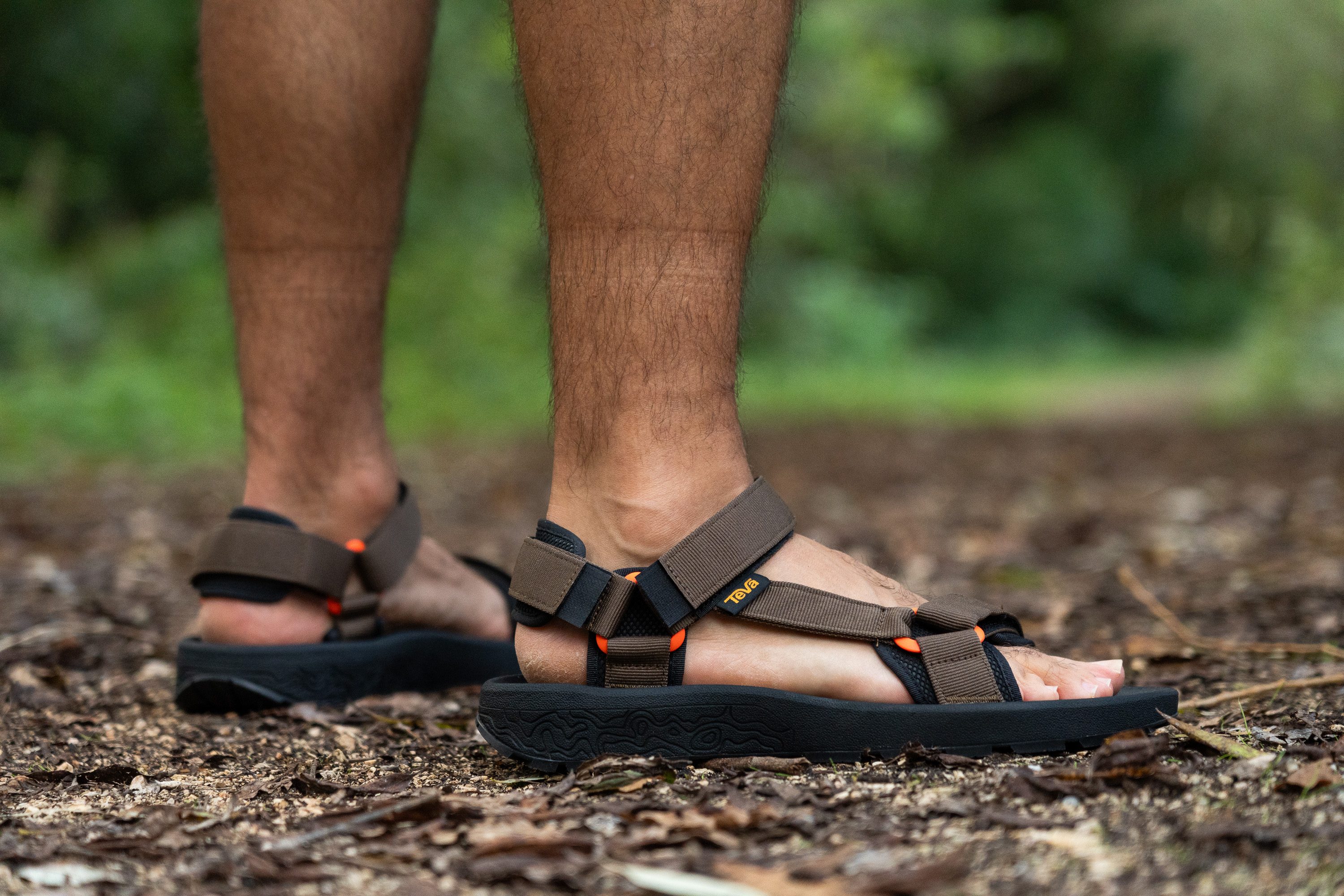
Quién NO debería comprárselas
Si necesitas unas sandalias más orientada al senderismo, creemos que es mejor que te hagas con unas de punta cerrada, que son más protectoras.
Las Hoka Hopara 2 y las KEEN Newport H2 son nuestras recomendaciones principales.
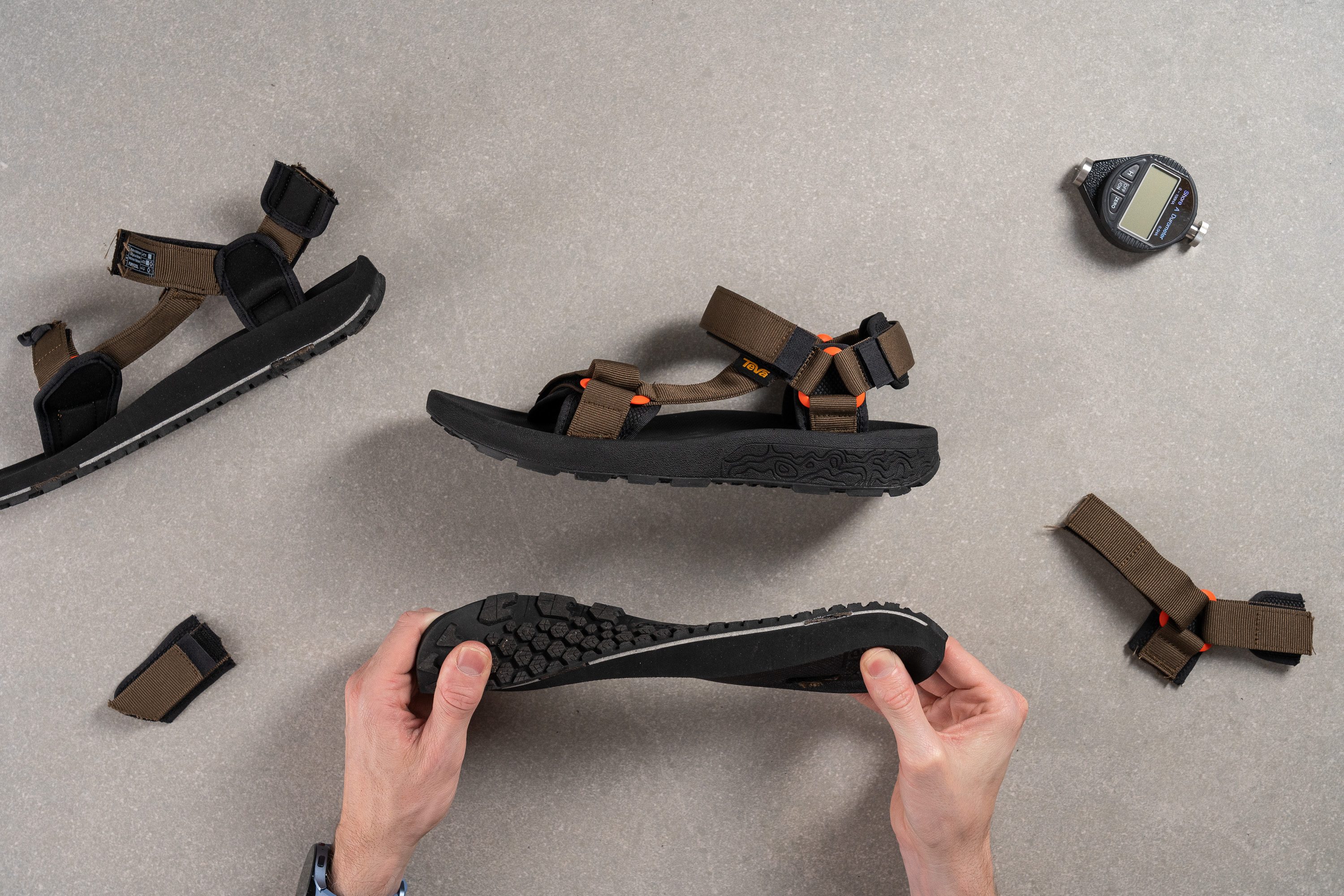
Amortiguación
Shock absorption
Esta sección está en desarrollo.
| Hydratrek | 116 SA |
| Media | 110 SA |
Energy return
Esta sección está en desarrollo.
| Hydratrek | 61.1% |
| Media | 55.3% |
Altura de la suela en la zona del talón
Estamos encantados de poder decirte que las Teva Hydratrek tienen casi tanta amortiguación como las populares Hurricane XLT2, que también son de esta misma marca. Cuando nuestro calibre midió la altura de la suela del talón, marcó un resultado superior a la media: 29,2 mm.
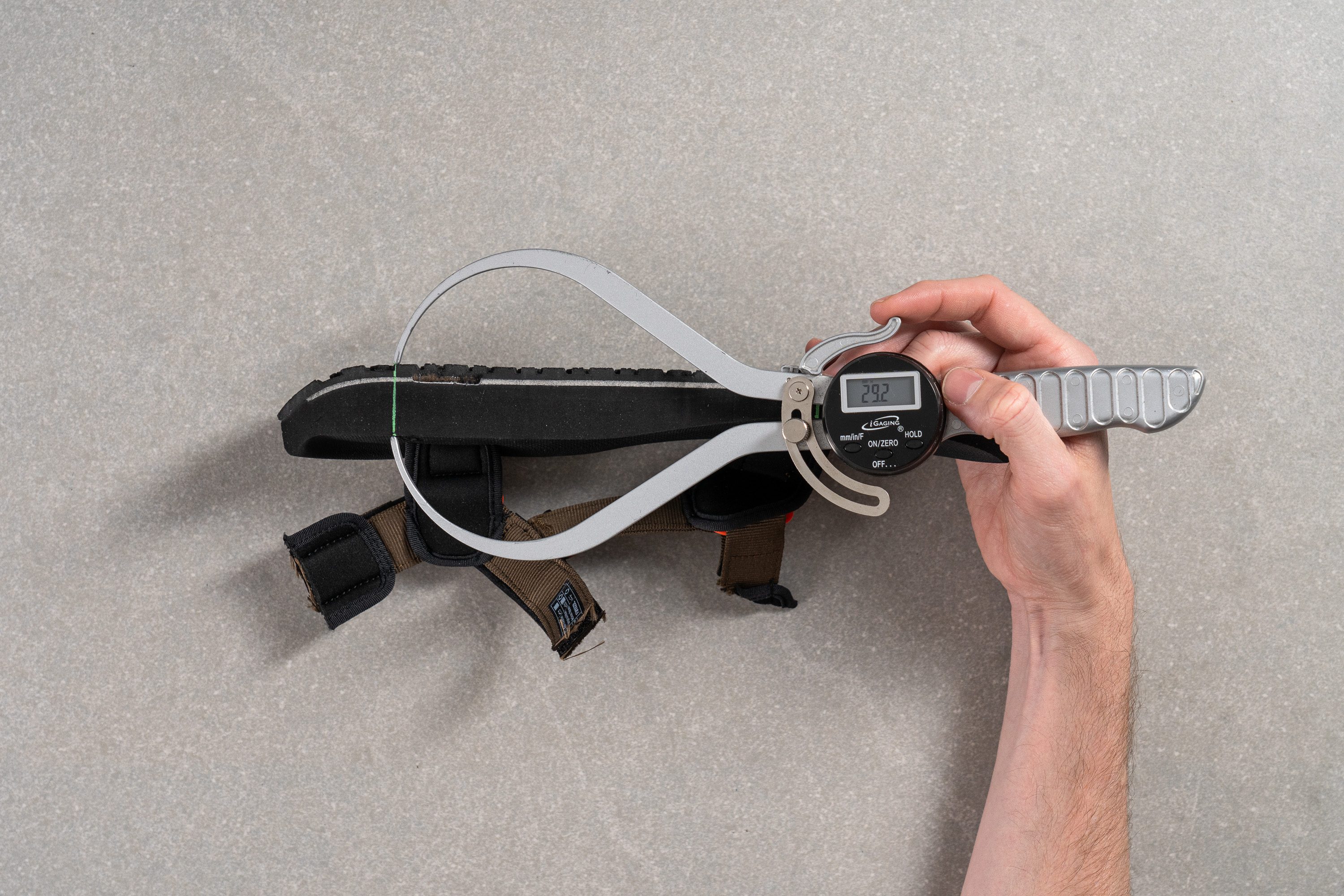
Esta cantidad de espuma hizo que nos sintiéramos seguros con las Hydratrek, ya que rindieron igual que unas sandalias de senderismo ligero. Su mediasuela consiguió amortiguar las conchas y las piedrecitas, ofreciendo la protección contra impactos de unas zapatillas para caminar propiamente dichas.
| Hydratrek | 29.2 mm |
| Media | 26.3 mm |
Altura de la suela en el antepié
La parte antepié de las Hydratrek tiene una suela más baja que la media, de 17,5 mm.
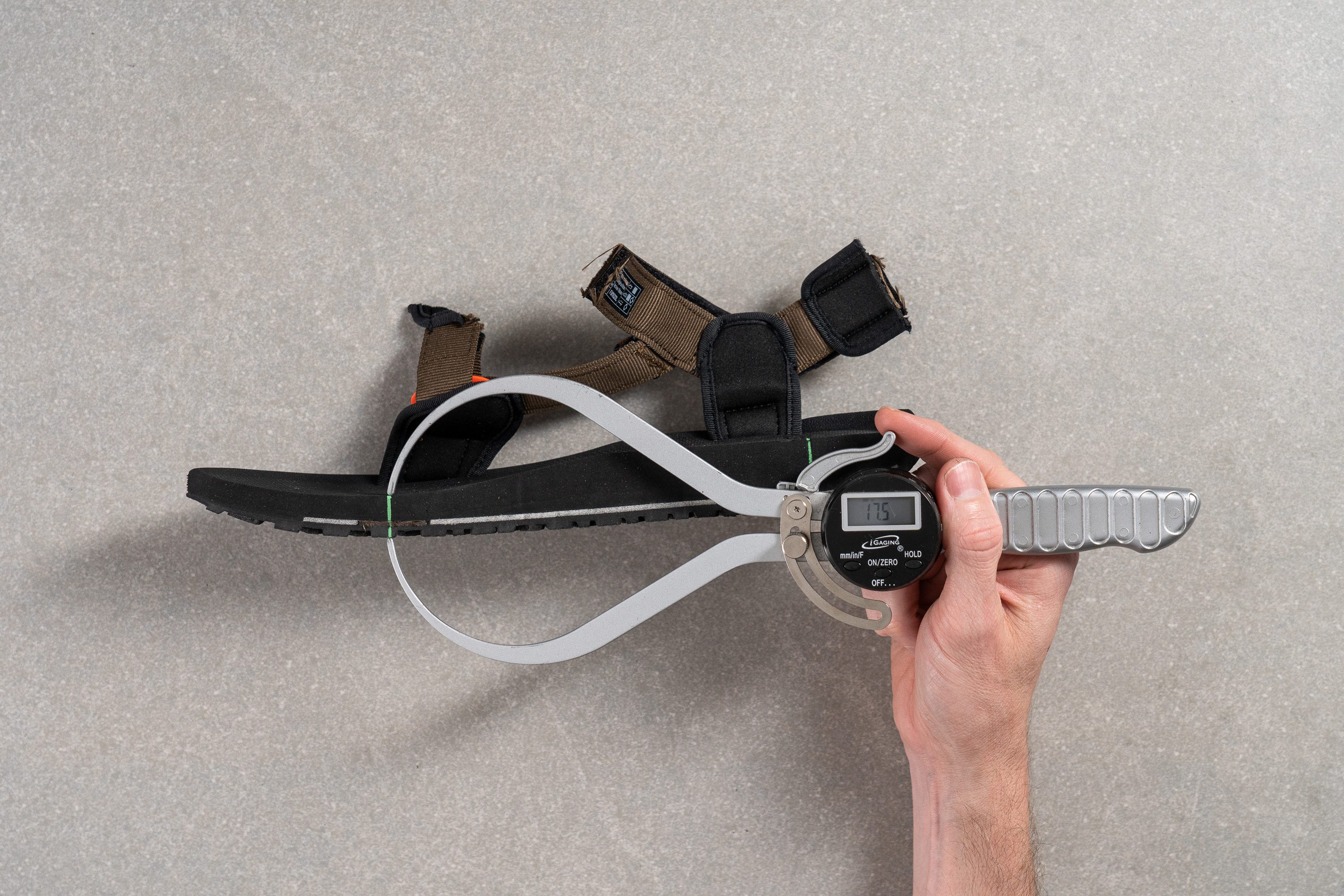
Aunque también es bastante más baja que el talón, descubrimos que sigue ofreciendo una protección esencial bajo los metatarsos. De todos modos, la ventaja principal es que esta suela más baja hace que te sientas más conectado con el suelo.
Sin ninguna duda, preferimos este mejor contacto con el suelo cuando nos tocó caminar de puntillas por las orillas llenas de rocas de los ríos cuando nos tocó mantener el equilibrio sobre una tabla de paddle surf.
| Hydratrek | 17.5 mm |
| Media | 18.5 mm |
Drop
Si miramos las Hydratrek de perfil, se puede ver que su drop es muy pronunciado. De hecho, es superior a la media, con 11,7 mm.
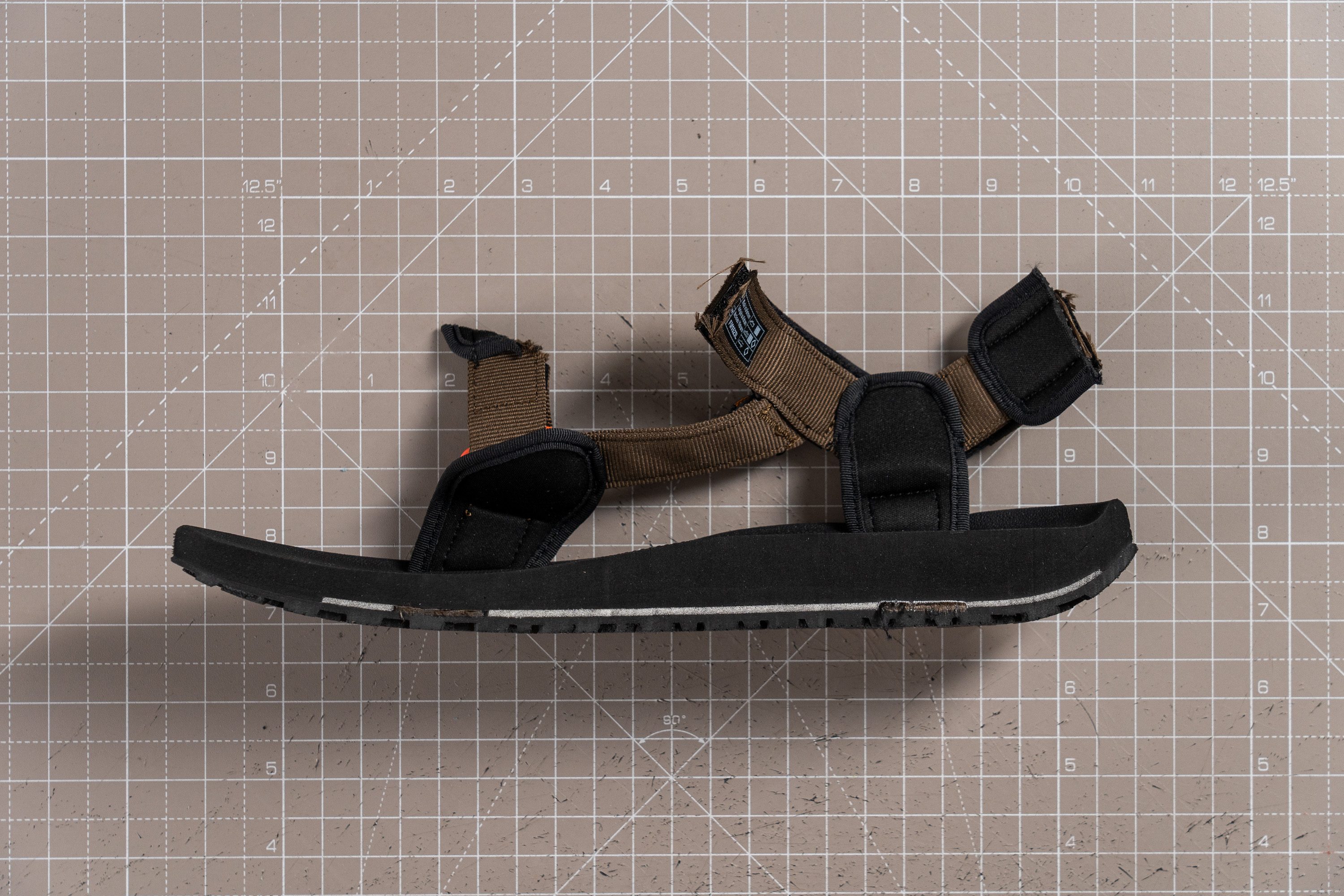
En nuestra experiencia, este drop hizo que las Teva Hydratrek se sintiese más como un híbrido entre unas sandalias y unas zapatillas, haciéndolas incluso más cómodas para caminar después de las actividades acuáticas. Vamos, que no es un par de neopreno que te quieres quitar nada más llegar a la orilla.
Como el talón es alto, no hace que el tendón de Aquiles tenga que trabajar más de la cuenta, además de que proporciona una buena amortiugación.
| Hydratrek | 11.7 mm |
| Media | 7.8 mm |
Suavidad de la mediasuela
Otra razón por la que pensamos que las Teva Hydratrek son especiales en comparación con unas sandalias de senderismo estándar es que su espuma EVA es más blanda que la media.
Cuando presionamos nuestro durómetro contra ella, marcó 18,9 HA. Este resultado es, con diferencia, el más bajo que hemos visto en unas sandalias de senderismo. Para que te hagas una idea de lo que esto significa, la mediasuela de este modelo es un 50 % más blanda que la de la media de las sandalias y un 15 % más blanda que la de las Teva Hurricane XLT2.
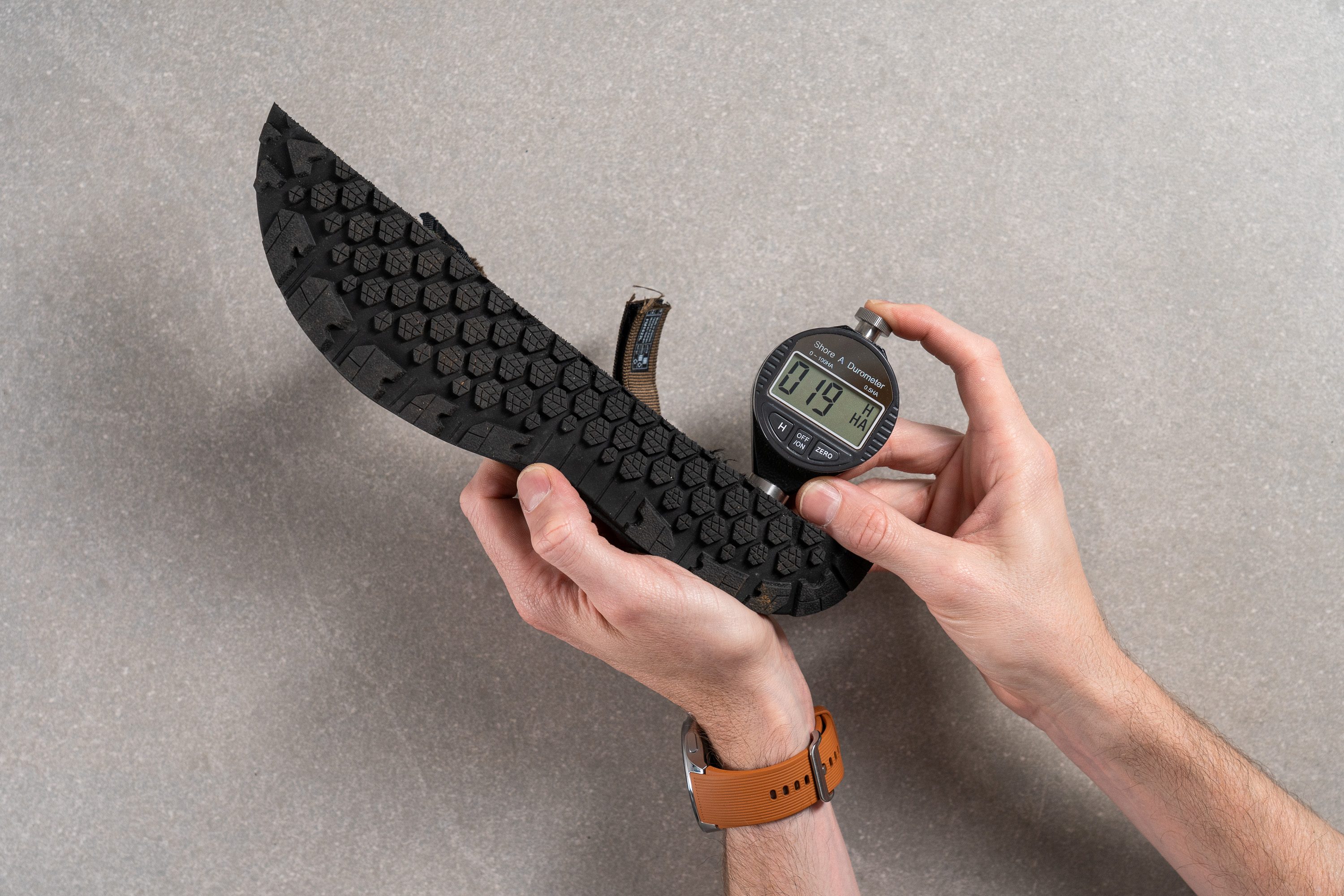
Pero, espera, no nos malinterpretes: ¡con esto no queremos decir que sea mullidísima! Las Hydratrek tienen una plataforma con la firmeza justa para proporcionar sujeción.
| Hydratrek | 18.9 HA |
| Media | 26.1 HA |
Tallaje y ajuste
Talla
Las Teva Hydratrek tallan bien (31 votos).
Toebox width - widest part
We believe that people of all foot shapes and sizes will find the Hydratrek's fit accommodating.
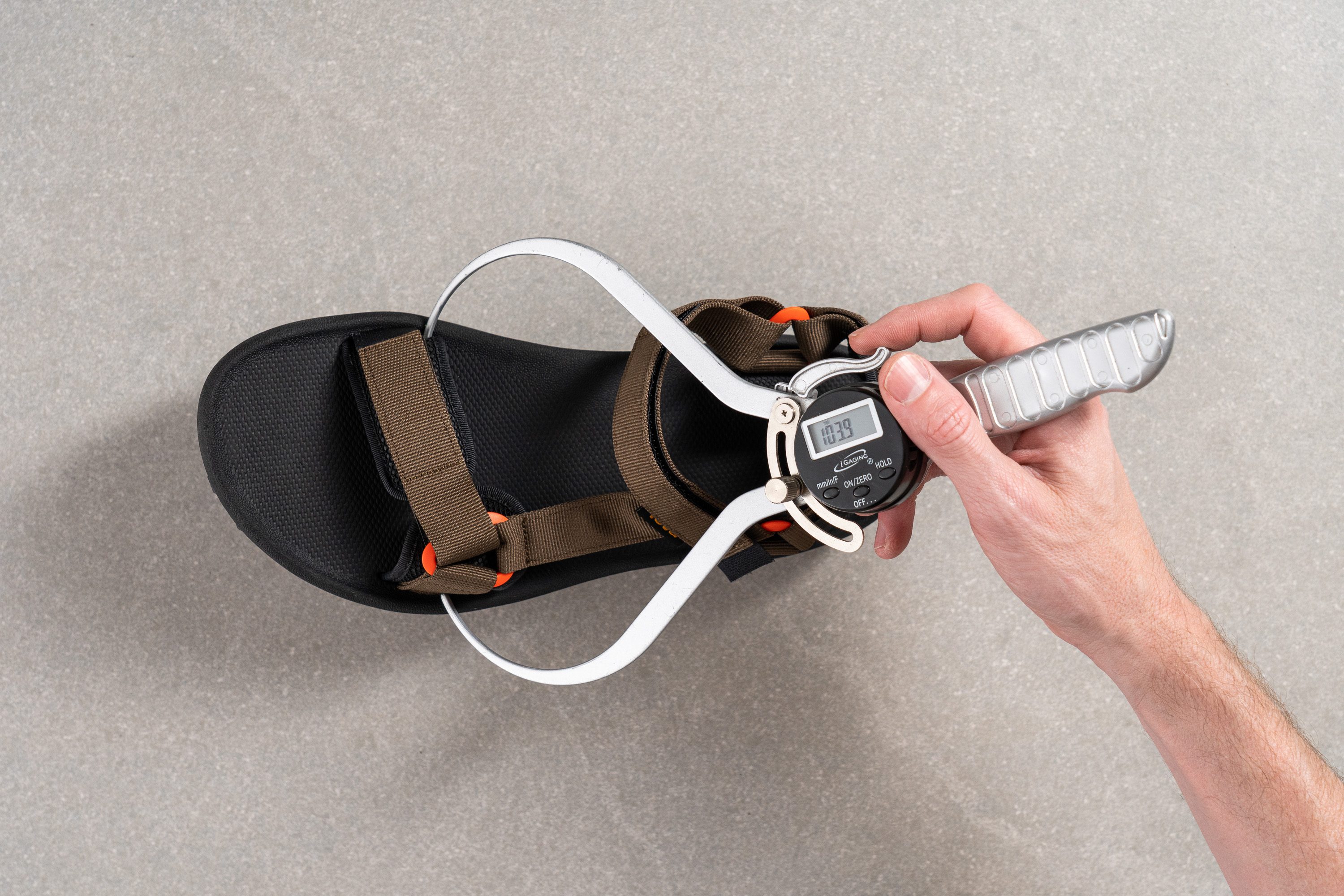
The distance between its forefoot strap attachments showed 103.9 mm in a men's US size 10 which is plenty enough for a medium-width foot.
Meanwhile, people with wider feet and bunions can easily regulate the tightness as all three straps on the sandal are adjustable.
En esta prueba se utiliza una metodología antigua, así que no verás las zapatillas que hemos analizado últimamente en la tabla. Los resultados obtenidos con metodologías distintas no se pueden comparar.
| Hydratrek | 103.9 mm |
| Media | 102.6 mm |
Tracción / Agarre
Profundidad del dibujo de la suela
Hablando de los tacos, los de las Hydratrek tienen una profundidad moderada de 2,6 mm. Aunque no son de los más profundos, nos han demostrado que no tienen problemas ni con las rocas mojadas, ni con la madera resbaladiza, ni con los senderos sencillos.
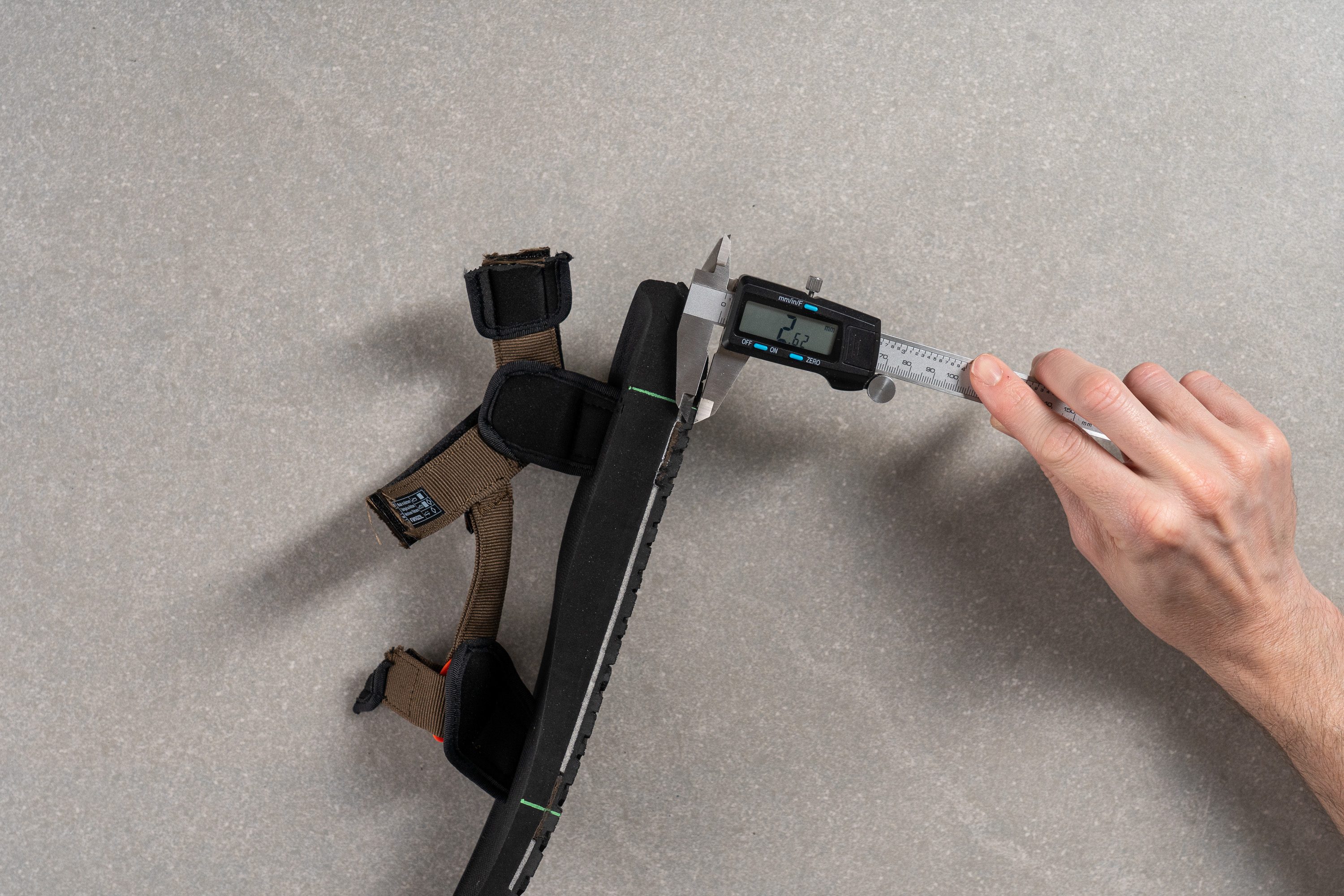
También descubrimos que la marca reinventó totalmente el dibujo de la suela de las Hydratrek, mejorando mucho su agarre. Diríamos que ha sido un paso hacia delante, pero como según Teva este nuevo diseño está inspirado en las ranas de árbol, vamos a decir que ha sido todo un salto.
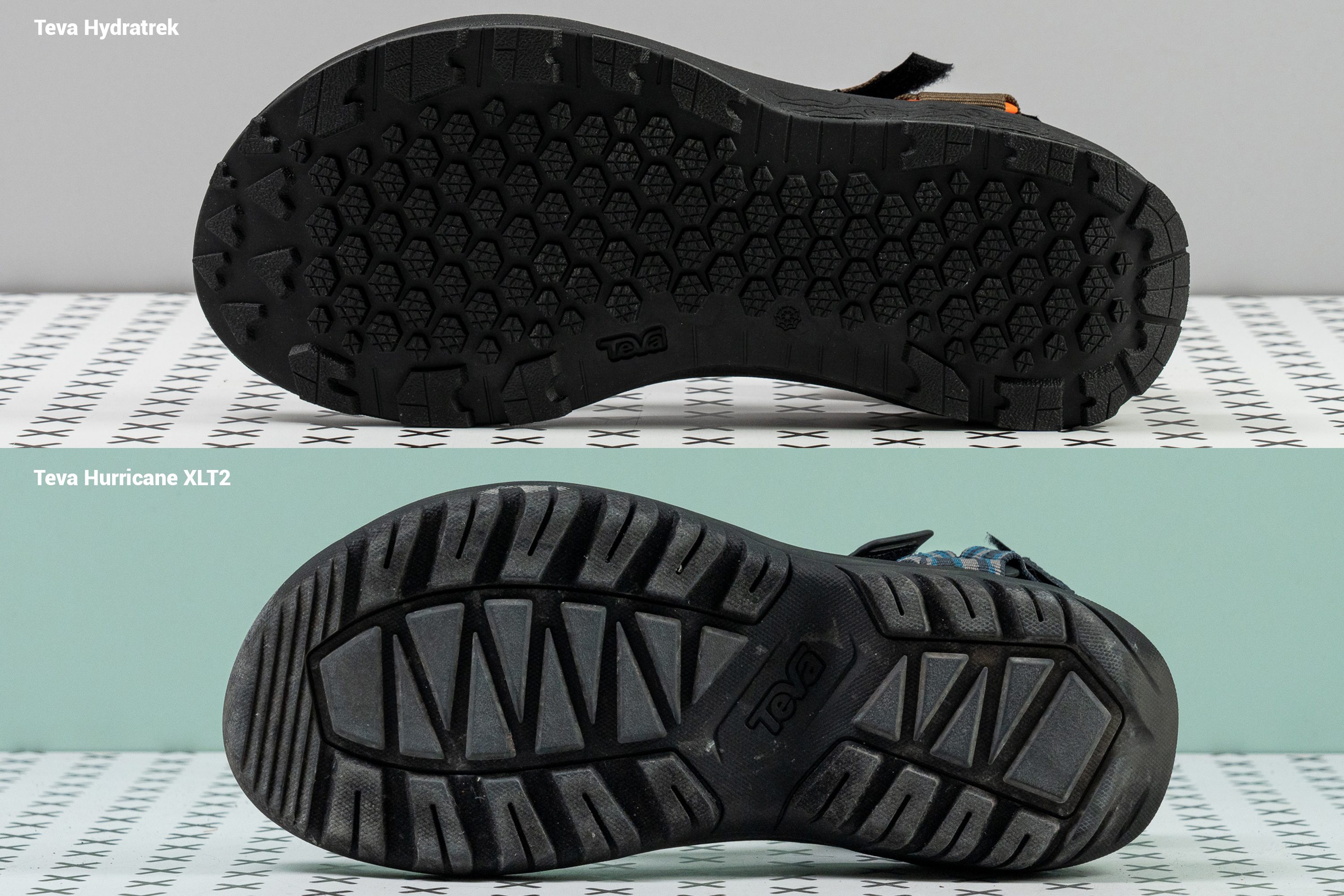
Los tacos son más pequeños pero también más dentados, formando canales para el aire menos profundos que hacían una especie de efecto ventosa en las superficies lisas y mojadas.
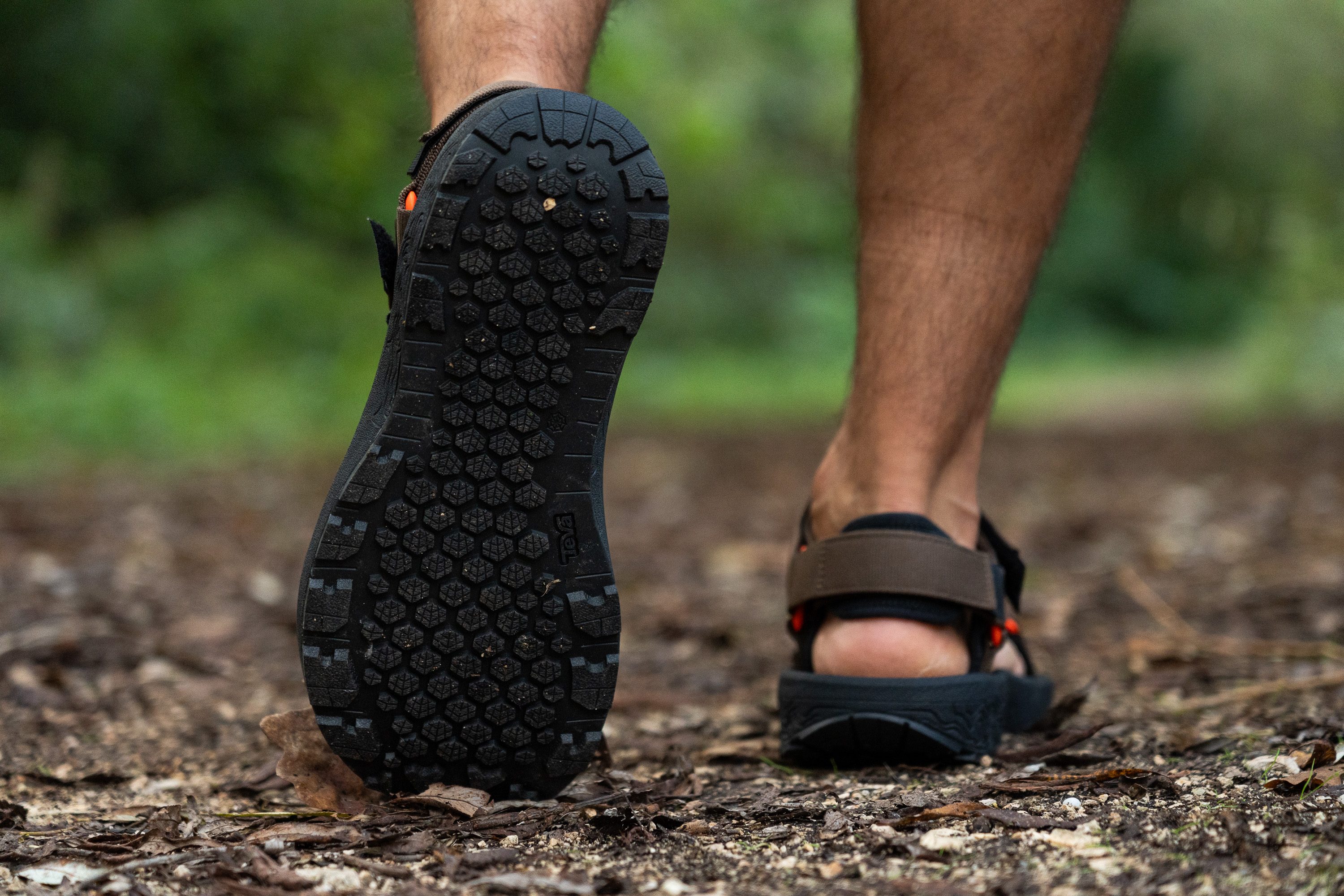
Lo único de lo que te queremos advertir es de que se le suelen quedar piedrecitas, tierra o cualquier resto de algo que pises atascado entre los tacos. Nuestra recomendación es que la limpies lo antes posible para evitar que se te queden ahí incrustados, porque si no después te costará un montón.
| Hydratrek | 2.6 mm |
| Media | 2.9 mm |
Flexibilidad / Rigidez
Cuando nos arrodillamos en la tabla de SUP, notamos inmediatamente que las Hydratrek se doblaban mucho más fácilmente en el antepié. Su mediasuela, que es fina y blandita, no nos puso tanta presión en los metatarsos como nos ha pasado con la de otras sandalias.
De vuelta al laboratorio, descubrimos que estas Teva necesitaban menos fuerza para doblarse en un ángulo de 30 grados que la media. Nuestra máquina marcó que necesitábamos 7,4 N de fuerza, así que las Hydratrek son unas de las sandalias más flexibles que hemos tenido en el laboratorio.
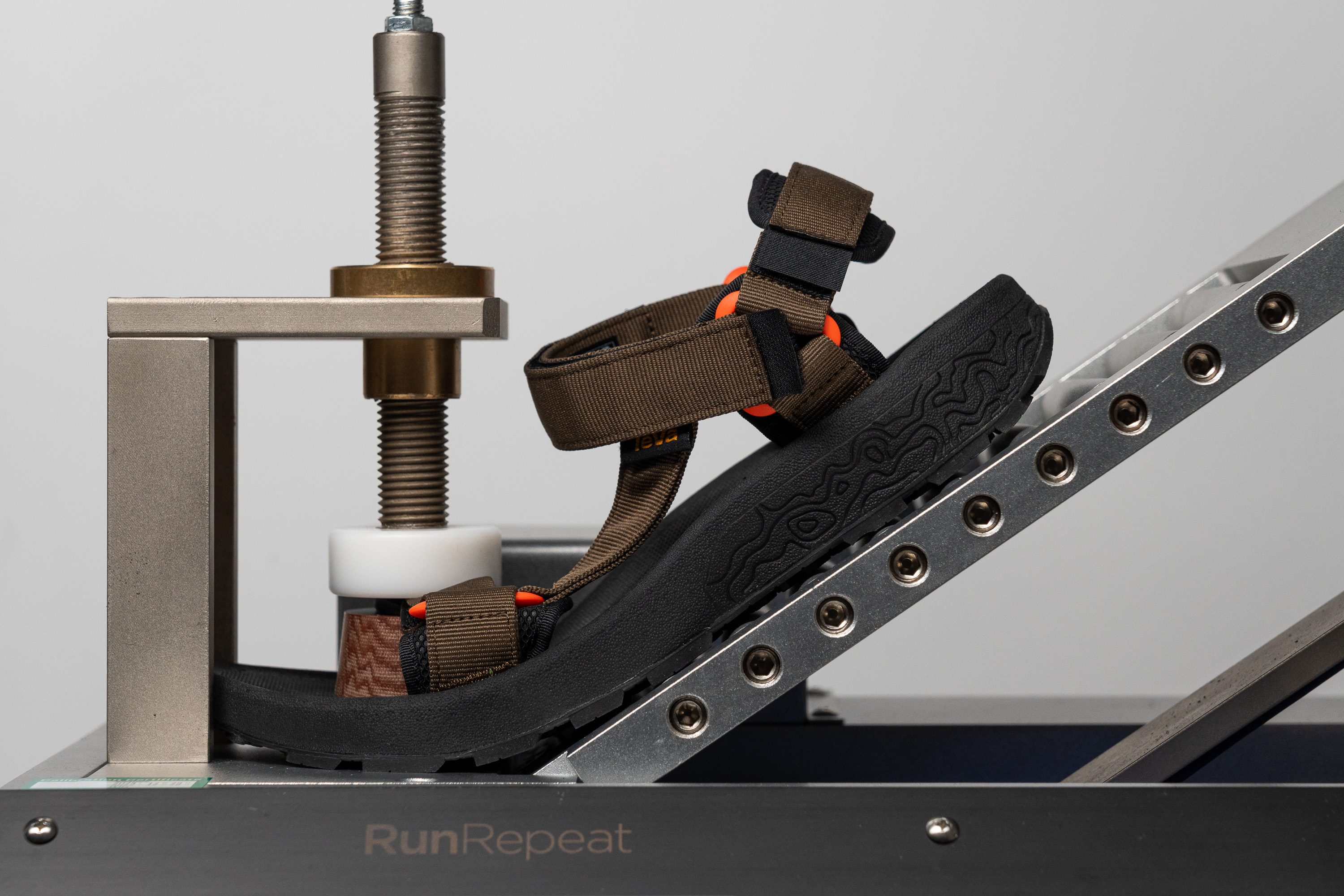
| Hydratrek | 7.4N |
| Media | 9.2N |
Peso
Como son unas sandalias con correas y una mediasuela de tamaño estándar, las Teva Hydratrek no nos parecieron más voluminosas que unas sandalias de senderismo estándar.
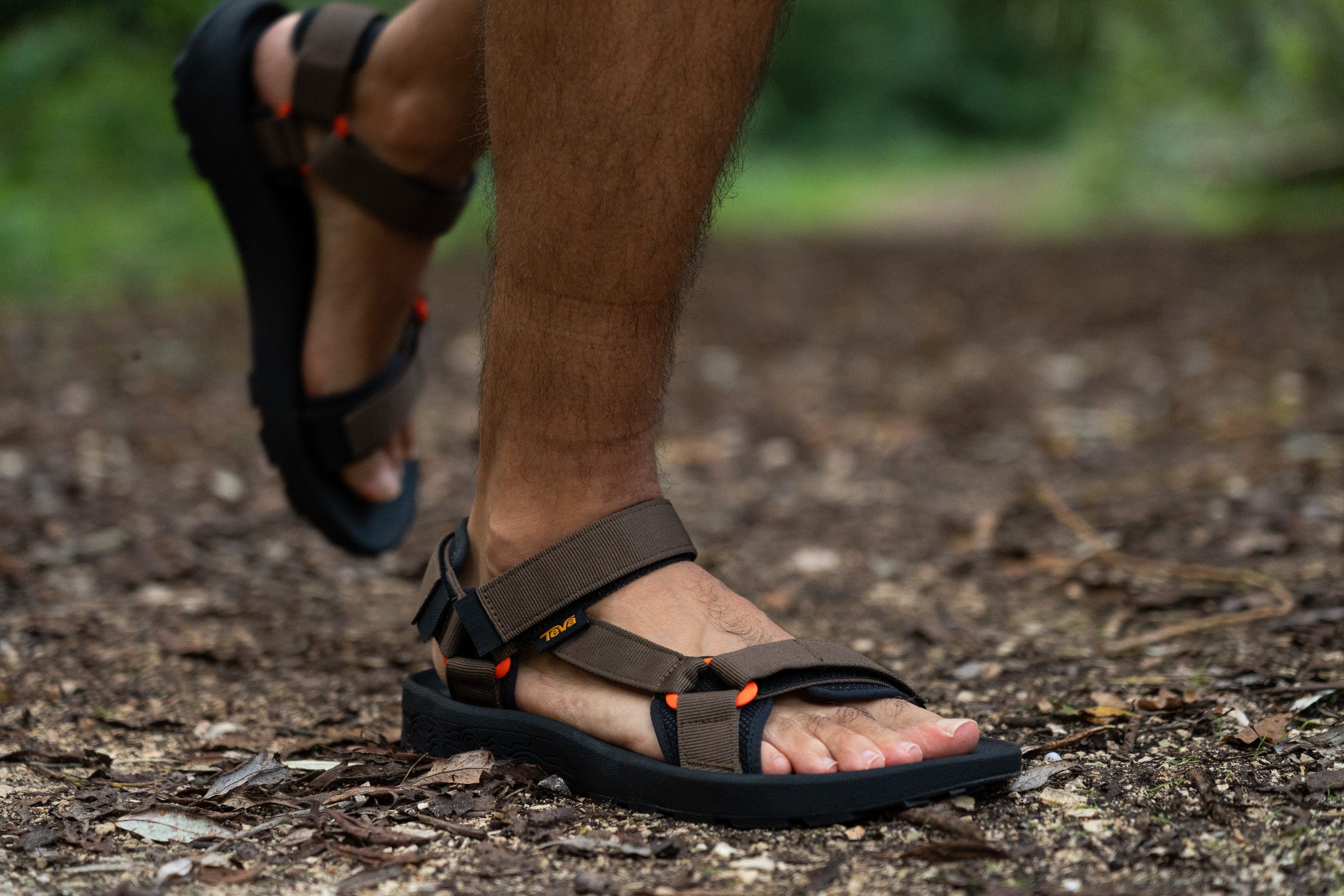
Con un peso de 304 g, pesan lo mismo que las Hurricane XLT2, que también son un poquito más ligeras que la media.
| Hydratrek | 10.8 oz (305g) |
| Media | 11.0 oz (313g) |
Estabilidad
Prueba de estabilidad lateral
La estabilidad que pueden proporcionar unas sandalias de senderismo tiene un límite, pero las Teva Hydratrek se aseguran de que sea suficiente.
Su amplia plataforma ofrece una gran superficie de apoyo, además de que tienen un arco alto que ofrece sujeción.
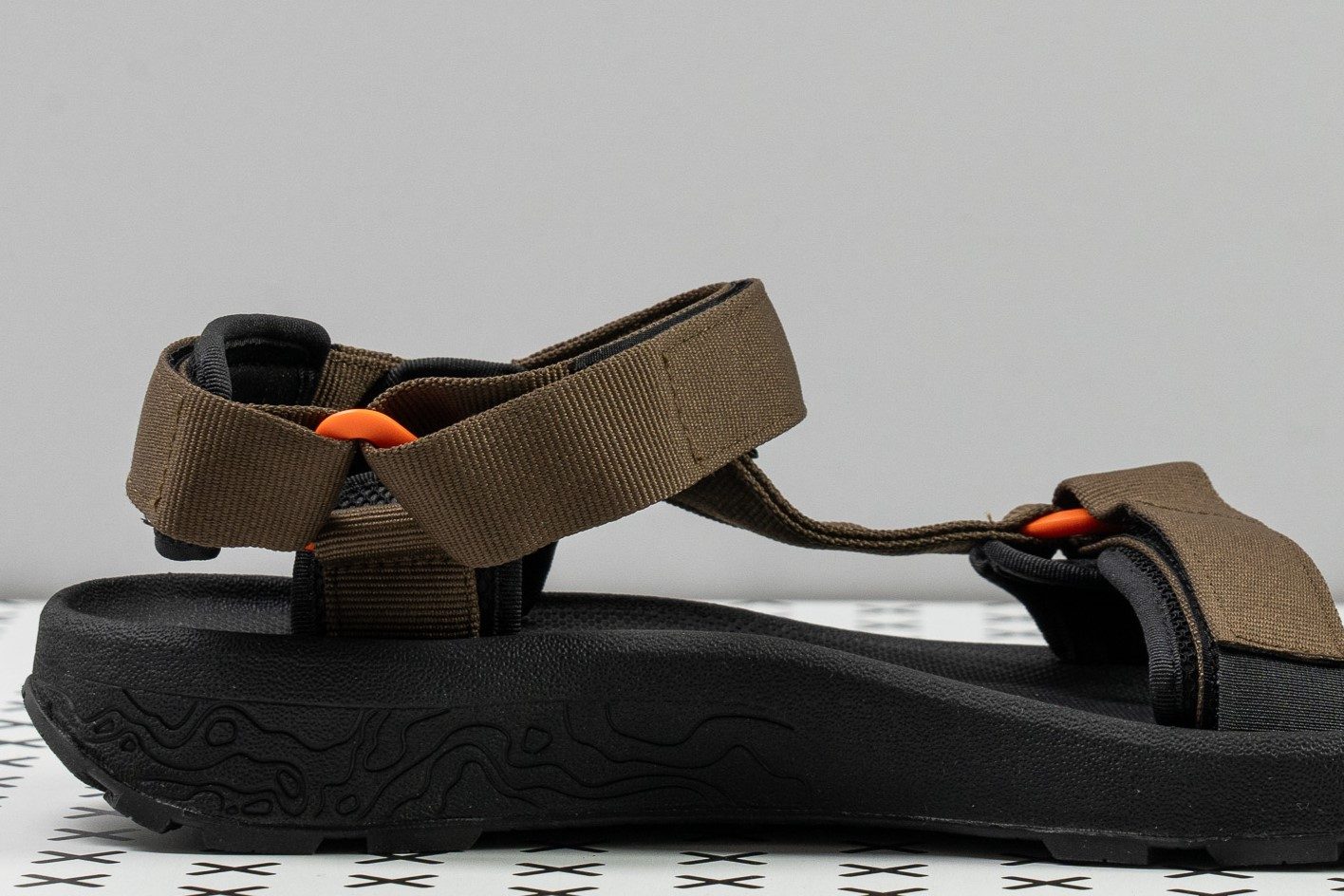
También queremos señalar que la parte de arriba de la suela tiene relieve, evitando así que nuestros pies se resbalaran cuando se nos mojaban las sandalias. Nos parece un detalle importante para la seguridad general de las Hydratrek, además de que estamos contentos de que ese relieve no nos hiciese daño cuando íbamos sin calcetines, que es algo que nos pasó con algunos de los modelos más antiguos de Teva.
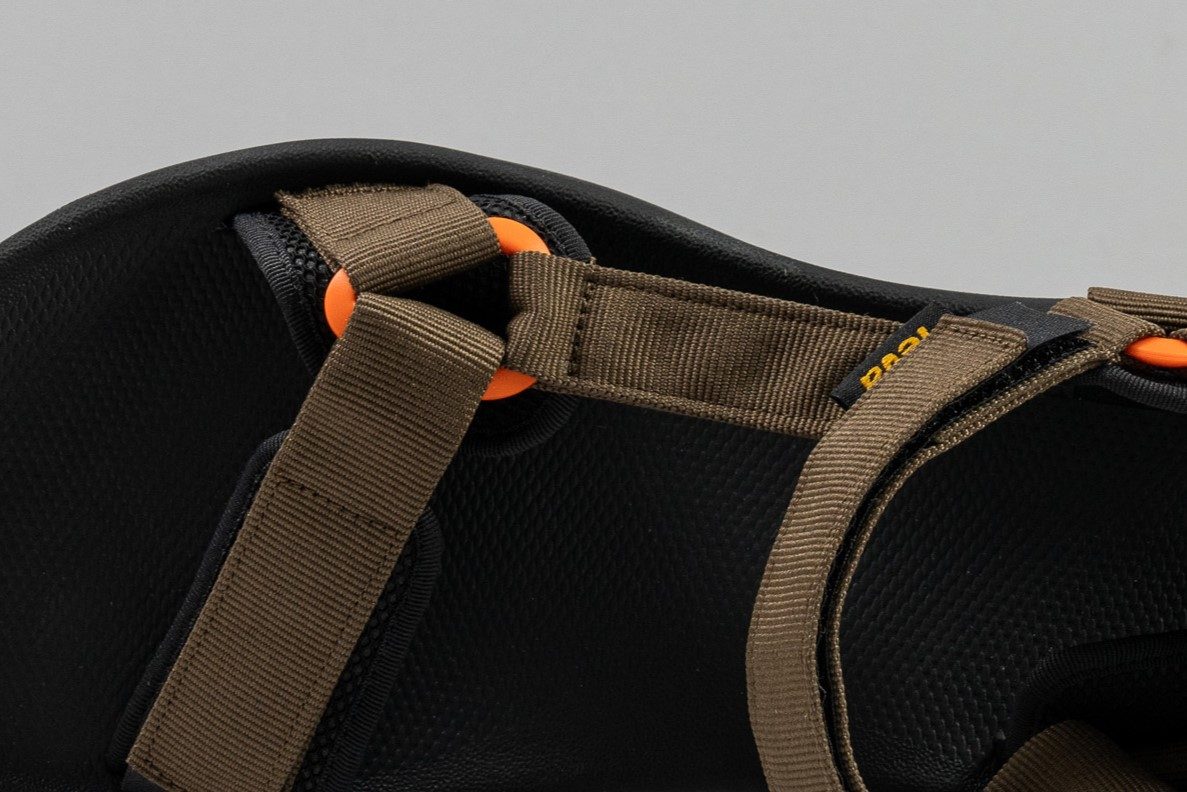
Rigidez torsional
En una escala de rigidez del 1 al 5 (donde 5 es la mayor rigidez), creemos que las Hydratrek están en el lado más flexible del espectro, ya que se llevaron un 2 en nuestra prueba.
Como demostró nuestra prueba manual, la rigidez torsional de estas sandalias es prácticamente nula. Vamos, que no son las sandalias con la mejor sujeción que hemos analizado (para esto están las Hoka Hopara 2), por lo que a lo mejor no son la mejor opción para alguien que tenga sobrepronación severa.
| Hydratrek | 2 |
| Media | 2.6 |
Anchura de la mediasuela - antepié
Como de costumbre, Teva se aseguró de que la mediasuela de sus sandalias de senderismo fuera ancha.
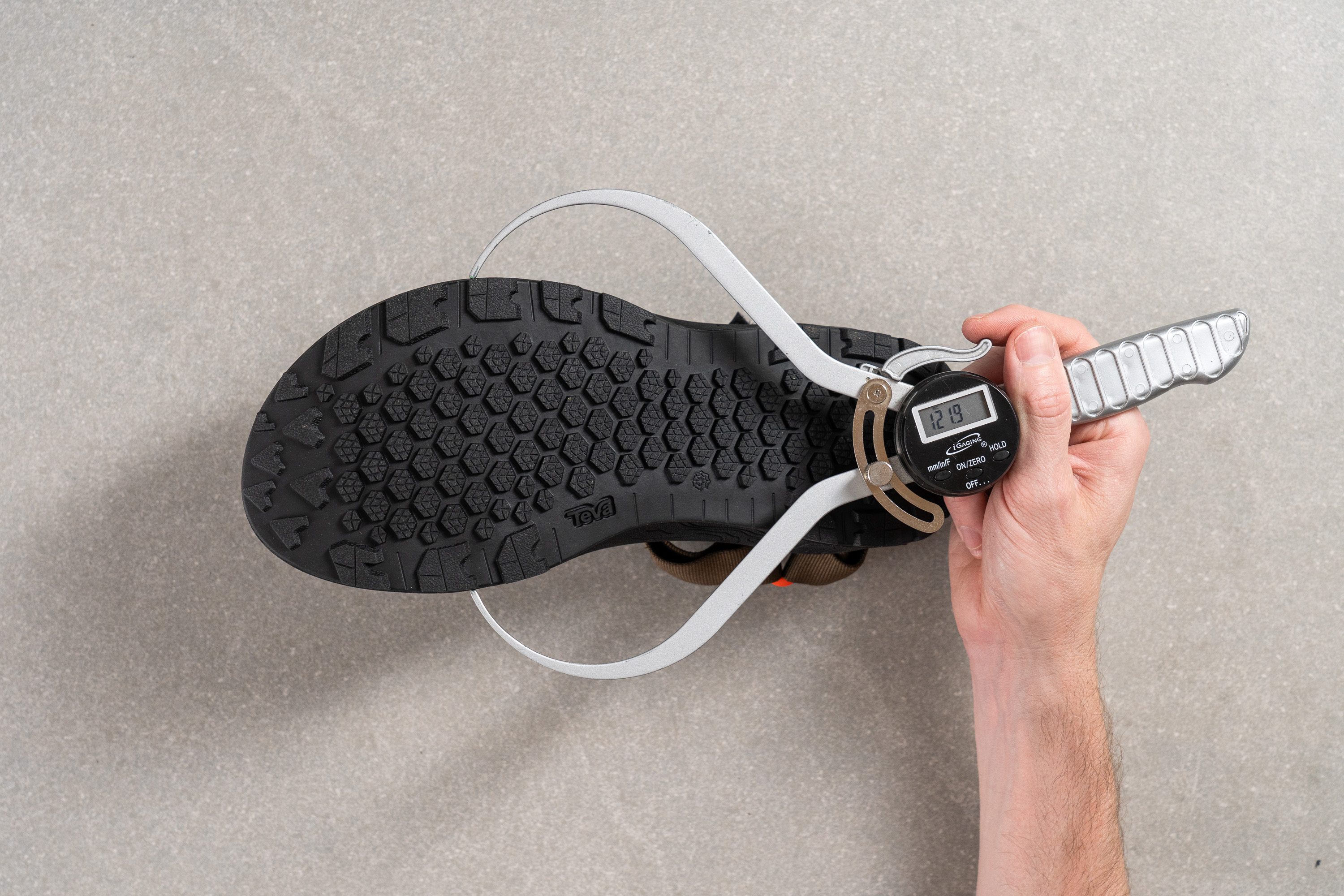
Con una generosa anchura de 121,9 mm en el antepié, las Hydratrek hicieron que nos sintiésemos estables y llenos de confianza en cada paso, ya fuera en senderos sencillos, en la playa, o en la orilla de un río llena de rocas.
| Hydratrek | 121.9 mm |
| Media | 119.0 mm |
Anchura de la mediasuela - talón
Las dimensiones del talón de las Hydratrek también demostraron ser lo suficientemente anchas para las personas que pisan mucho con el talón.
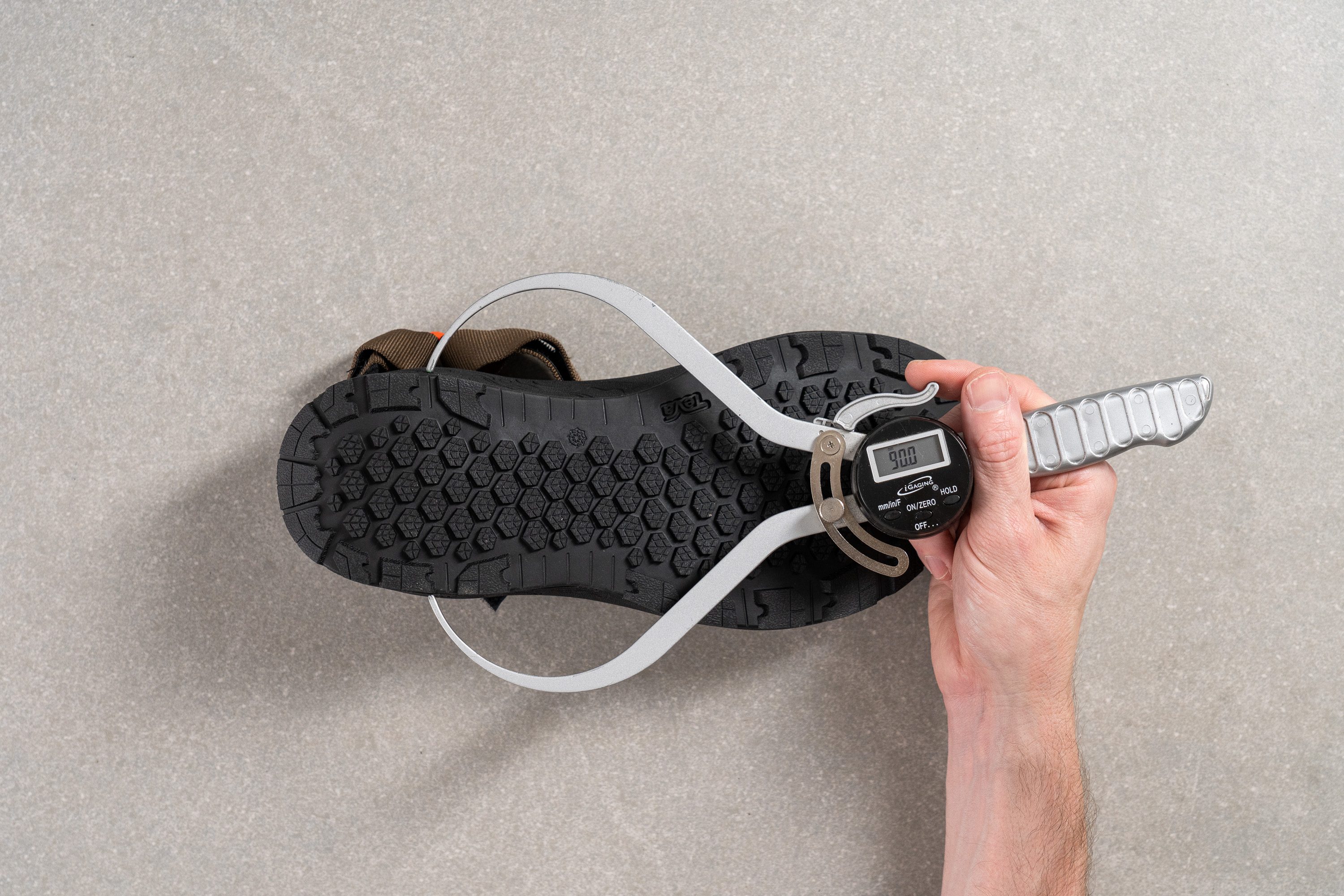
Nuestro calibre marcó 90,0 mm en su punto más ancho, así que están a la par con la media.
| Hydratrek | 90.0 mm |
| Media | 91.6 mm |
Durabilidad
Dureza de la suela
Es muy común que las sandalias de senderismo utilicen un caucho blando para agarrarse mejor al terreno mojado, así que no nos sorprendió nada que nuestro durómetro marcase 77,6 HC cuando analizamos el de estas. Mira, para darte algo más de contexto, la dureza media del caucho de las zapatillas de senderismo es de 85,0 HC.

| Hydratrek | 77.6 HC |
| Media | 80.5 HC |
Durabilidad de la suela
Eso sí, al ser más blanda, la suela exterior de las Hydratrek no consiguió los mejores resultados en nuestra prueba Dremel.
Después de 22 segundos de tortura a una velocidad de 10K RPM, el caucho de estas Teva no salió muy bien parado. Nuestro medidor de desgaste de neumáticos marcó que la profundidad de la zona dañada alcanzaba los 1,4 mm.
Esto significa que utilizar las Hydratrek sobre superficies muy abrasivas (como rocas o asfalto) durante largos períodos de tiempo hará que su suela exterior se desgaste más rápido.

Pero bueno, dejando eso a un lado, queremos decirte que los resultados de la suela exterior de las Hydratrek en cuanto a durabilidad concuerdan con los de otras sandalias de Teva que hemos analizado. Por lo tanto, si has tenido o tienes otras sandalias de esta marca, te puedes esperar que la suela exterior vaya a durar más o menos lo mismo.
| Hydratrek | 1.4 mm |
| Media | 1.5 mm |
Grosor de la suela
Lo bueno es que el grosor de del caucho de las Hydratrek también está a la par con la media, alcanzando los 2,4 mm sin contar los tacos.

| Hydratrek | 2.4 mm |
| Media | 2.5 mm |
Varios
Upper material thickness
Parece que Teva les ha puesto incluso más acolchado a las correas para que estas sandalias sean más cómodas cuando las usas durante mucho rato.
Pero claro, como este forro no está totalmente cosido a las correas, a lo mejor tienes que ajustarlo un poco con los dedos para que no se te doble cuando te pones las sandalias. Es posible que esto no le haga mucha gracia a algunas personas.
Al medir el grosor de las correas de las Hydratrek nos dimos cuenta de que, efectivamente, son más gruesas, ya que nuestro calibre marcó un resultado más alto que la media: 7,5 mm.
| Hydratrek | 7.5 mm |
| Media | 4.3 mm |
Precio
Aunque las Hydratrek son más caras que las otras sandalias de Teva, su precio sigue estando por debajo de la media de las sandalias de senderismo.
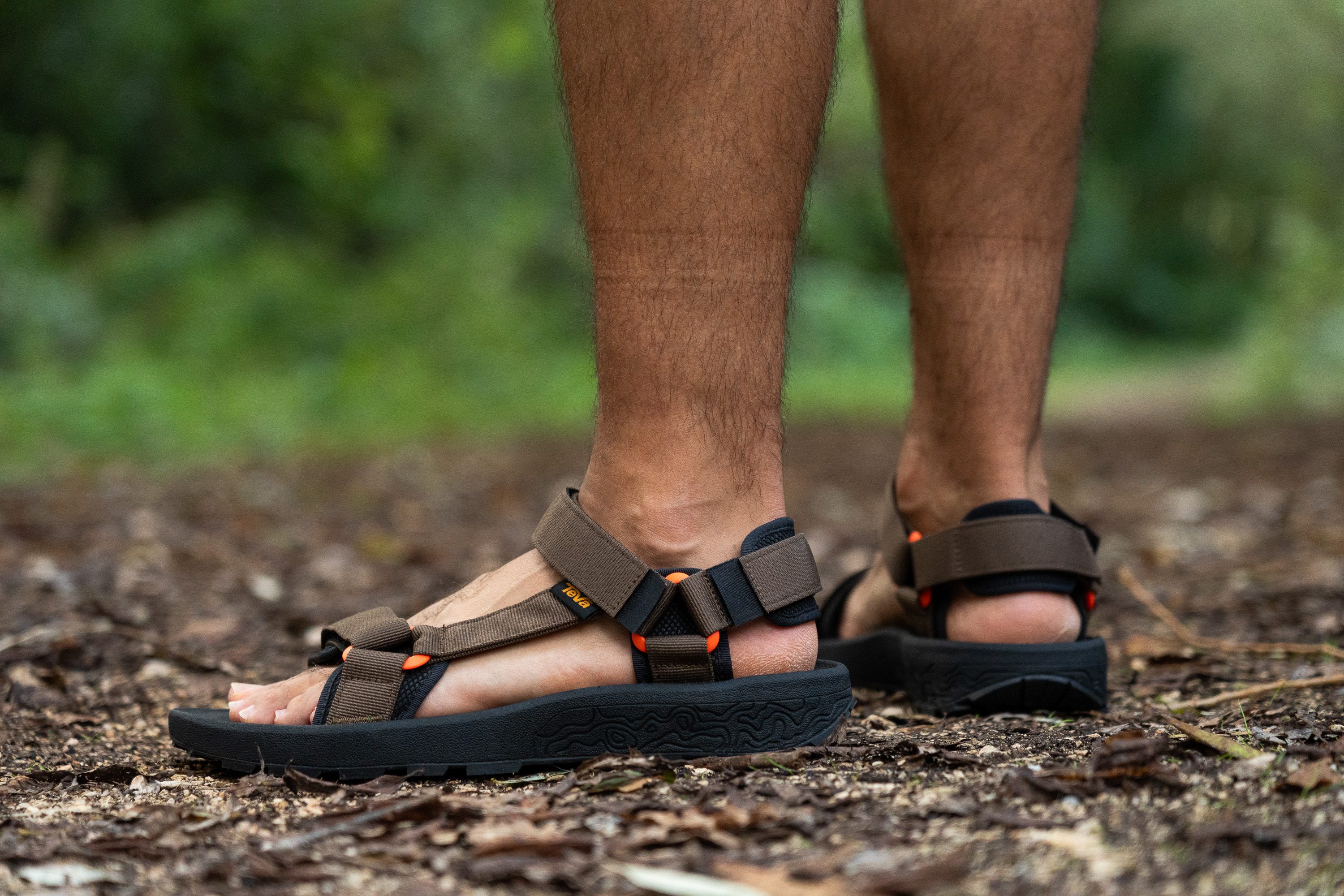
En nuestra opinión, la comodidad, el agarre y lo fáciles que son de usar las Hydratrek hacen que su precio merezca la pena.
| Hydratrek | $85 |
<p>Materiales sostenibles</p>
Según Teva, las Hydratrek cuentan con bastantes componentes reciclados:
- 30 % de caucho Spider reciclado en la suela exterior.
- 100 % de plástico reciclado en las correas (hilo de poliéster REPREVE verificable).
- 60 % de poliéster reciclado en los forros acolchados bajo las correas.
- 30 % de EVA reciclada en la mediasuela.
